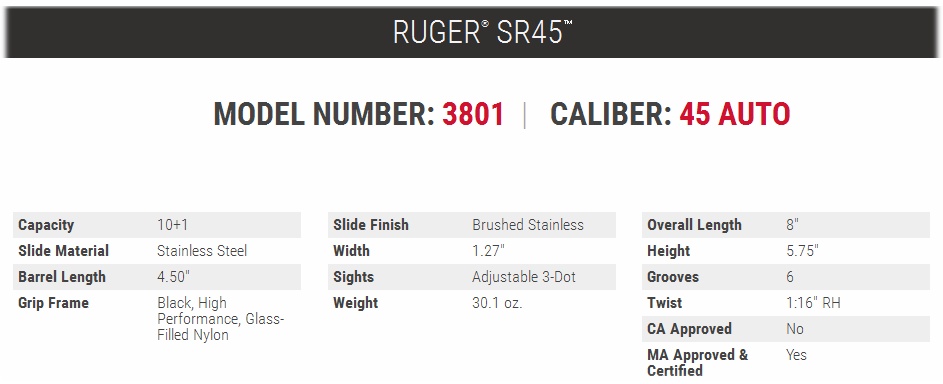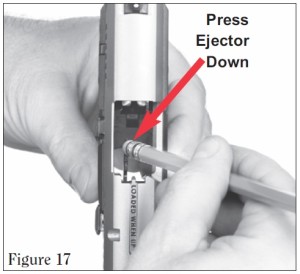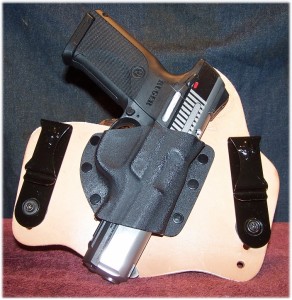The SR45 is a polymer-framed, full-sized, striker-fired, recoil-operated, semi-automatic pistol chambered in the powerful .45 ACP cartridge and featuring a 10+1 capacity (with 15-round and 17-round magazines available) that is based on the Ruger SR series, which was originally introduced in 2007.
I have to interject here that the firearms that I review are not Test & Evaluation firearms. I am not beholding to any manufacturer and information presented is a result of actual ownership and handling of the firearms. In fact, I am not beholding to much at all.
Before I purchase a firearm, I do as much research about it as I can; I view videos, read other reviews and, if possible, handle them at my local gun shop. The SR45 was chosen after much research, thought, and consideration even after viewing some negative about the pistol. Aside from my knowledge of the SR45, as an owner and operator, I am going to share with you some things to look for if you are considering having a SR45 of your own.
THE BASICS:
STYLING:
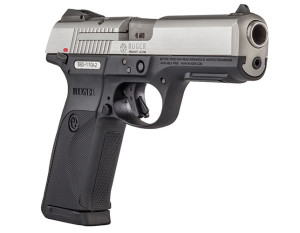 The Ruger SR45 is a large caliber pistol with a trim, ergonomic profile. In fact, the total width (1.27”) is less than the Ruger SR1911 (1.34”). However, the thumb safety of the Ruger SR1911 does contribute to the overall width. Essentially, the SR45 and SR1911 are the same width. This makes for a thin package for concealed carry.
The Ruger SR45 is a large caliber pistol with a trim, ergonomic profile. In fact, the total width (1.27”) is less than the Ruger SR1911 (1.34”). However, the thumb safety of the Ruger SR1911 does contribute to the overall width. Essentially, the SR45 and SR1911 are the same width. This makes for a thin package for concealed carry.
MODERN MANUFACTURING – SLIDE:
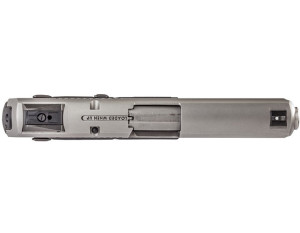 Slide design reduces slide velocity and recoil. The slide is nicely formed and blends near perfectly into the frame. The rear slide serrations are aggressive and definitely provide a gripping surface for moving the slide. The nicely-grained steel on the side of the slide is nicely contrasted with a brushed finish on top to cut glare. The SR45 utilizes an external extractor; a rather beefy one at that.
Slide design reduces slide velocity and recoil. The slide is nicely formed and blends near perfectly into the frame. The rear slide serrations are aggressive and definitely provide a gripping surface for moving the slide. The nicely-grained steel on the side of the slide is nicely contrasted with a brushed finish on top to cut glare. The SR45 utilizes an external extractor; a rather beefy one at that.
A laser-etched SR45 appears on the left side of the slide with a just-as-nicely laser etched Ruger and logo etched on the right side just above the PRESECOTT, AZ USA etching.
The front end of the slide is nicely finished. While I would like a smooth transition of metal from slide to muzzle, Ruger opted to disrupt the look with a vertical indention on each side of the slide. No problem, really.
The only interruption in the flow of the slide’s line are recessed areas that are used for chamber indicator and extractor pins.
Slide operation is not smooth. There is a whole lot going on internally in setting the trigger and the pistol sounds like a mechanical puzzle with all of the pieces going into place when the slide is racked. Albeit disconcerting, this indicates that the pistol is functioning properly.
The Ruger SR45 is available with a stainless steel slide or an excellent Nitride-finished carbon steel slide.
MODERN MANUFACTURING – FRAME:
The Ruger SR45 has an integral accessory mounting rail provides space for mounting lights, lasers and other tactical accessories.
The D-shaped magazine release is ambidextrous, a feature that southpaws and those who like to train strong and weak-handed will appreciate.
The SR45 utilizes a high-performance, glass-filled nylon, ergonomically-designed grip frame.
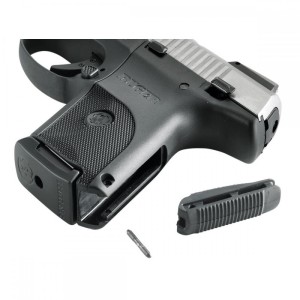 The grip’s back-strap has a rubberized insert that is removable and reversible. One side provides an arched profile; the other, a flat profile. While the SR45 is incredibly thin, I found it to be long, front to back, even in my good-sized hand. The flat back-strap was much more comfortable for me, but it is certainly nice to have the option. The back-strap is held in place with a steel cross-pin that serves double duty as an attachment point for a lanyard. With the flat back-strap in place, the SR45 is reminiscent of the grip on a 1911; a grip that I am totally comfortable with. I found that the arched back-strap pressed into my hand at the wrong spot and was uncomfortable. Some; however, may prefer the arched back-strap.
The grip’s back-strap has a rubberized insert that is removable and reversible. One side provides an arched profile; the other, a flat profile. While the SR45 is incredibly thin, I found it to be long, front to back, even in my good-sized hand. The flat back-strap was much more comfortable for me, but it is certainly nice to have the option. The back-strap is held in place with a steel cross-pin that serves double duty as an attachment point for a lanyard. With the flat back-strap in place, the SR45 is reminiscent of the grip on a 1911; a grip that I am totally comfortable with. I found that the arched back-strap pressed into my hand at the wrong spot and was uncomfortable. Some; however, may prefer the arched back-strap.
The small slide catch helps prevent accidental activation, especially when shooting with a firm two-handed grip.
The frame also incorporates an ambidextrous thumb safety (see SAFETIES)
The grip on the SR45 is exceedingly thin, to the point that, in hand, it feels like a single-stack gun despite its 10-round, double-stack magazine packed with fat .45 ACP cartridges. The grip is also very well, but mildly checkered, on the sides and front. The grip sides feature Ruger’s distinct heraldic-phoenix logo.
The grip, in my hand, feels slippery. That is probably due to the polymer material. When wearing shooting gloves (Harbinger), slippery is not an issue; however, with wet bare hands gripping the pistol, with the pistol rolling around in the hand, may be an issue. A product like Talon Grips may mitigate this challenge. I will note that I have the same issue with any polymer grip. If the SR45 was to be carried on a constant basis, I would probably opt for a finger-grove grip sleeve, but I leave grip options up to the operator.
The SR45 has an exceptional beaver-tail that assist the hand in getting as high up on the grip as possible without a care about slide bite. The beaver-tail is nicely rounded off and fits well in the hand. My hand just naturally finds its way into the beaver-tail.
The frame is fashioned such that I can get the maximum amount of grip possible with both firing and support hand. I cannot say that about a number of pistols and even some revolvers. Grip is very important when taking control of a pistol and placing shots where you want them placed.
Lastly, there is a nice undercut where the trigger housing blends into the frame, which helps the fingers to get up close and personal with the trigger housing. There is also a nice relieved portion at the top of the grip that makes a nice channel for the trigger finger and thumb.
TRIGGER:
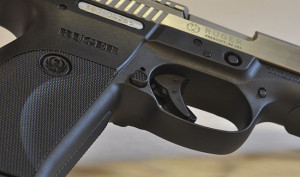 The trigger is, well, wonderful! The trigger on the SR45 is one of the smoothest I have experienced on a polymer-framed pistol (aside from the other SR series of pistols). Pull the slide to the rear about ½” to set the trigger. The only slack in this trigger is the distance the trigger safety (in technical terms, this is the “Trigger Flapper”). Once the trigger safety is fully pressed, resistance is encountered. There is no “wall” to overcome that is common with most triggers. This trigger loves a consistent and constant pull. Once the striker is released, as indicated by a very crisp break, there is virtually no over-travel.
The trigger is, well, wonderful! The trigger on the SR45 is one of the smoothest I have experienced on a polymer-framed pistol (aside from the other SR series of pistols). Pull the slide to the rear about ½” to set the trigger. The only slack in this trigger is the distance the trigger safety (in technical terms, this is the “Trigger Flapper”). Once the trigger safety is fully pressed, resistance is encountered. There is no “wall” to overcome that is common with most triggers. This trigger loves a consistent and constant pull. Once the striker is released, as indicated by a very crisp break, there is virtually no over-travel.
Trigger pull is reminiscent of a light, short double-action revolver in some ways. There is no trigger “stacking” or “staging” as can occur with a double-action trigger system, however. The trigger pull on my particular SR45 is around a little over 7 pounds, but it seems to be much lighter. Reset is long, and again, reminiscent of a double-action trigger where the trigger is almost all the way forward before it resets.
SIGHTING SYSTEM:
Dovetailed, high-visibility 3-dot sight system features a raked-forward front sight for easy removal from the holster and an adjustable rear sight.
The entire adjustable, rear sight is recessed into the slide and blends well into the grand scheme of things. The dual white dots on the rear sight are smaller than the front sight dot, which adds contrast. On my particular SR45, the front sight dot will receive some fluorescent red sight paint to provide even more of a contrast with the rear sight.
SAFETIES:
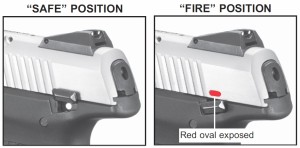 Both internally and externally the Ruger SR45 has multiple safety features. The ambidextrous thumb safety locks the trigger and trigger bar, preventing any backward movement. The thumb safety clicks to either safe or off-safe positions easily and a red-colored inset on the slide tell the operator when the pistol is in the “off safe” position. Like a 1911-based pistol, when the lever is down, the pistol is ready to fire. I am not a fan of the thumb safety, however. The safety lever, to me, is to far rearward; I have to change my grip slightly to place the safety in either position. Also, when shooting right-handed, as most do, the right side lever would pinch my hand if I did not shift my grip. Additionally, and while I could press the safety lever down (off safe) with my thumb, I could push the lever to the safe position; I have to use the thumb of my support hand.
Both internally and externally the Ruger SR45 has multiple safety features. The ambidextrous thumb safety locks the trigger and trigger bar, preventing any backward movement. The thumb safety clicks to either safe or off-safe positions easily and a red-colored inset on the slide tell the operator when the pistol is in the “off safe” position. Like a 1911-based pistol, when the lever is down, the pistol is ready to fire. I am not a fan of the thumb safety, however. The safety lever, to me, is to far rearward; I have to change my grip slightly to place the safety in either position. Also, when shooting right-handed, as most do, the right side lever would pinch my hand if I did not shift my grip. Additionally, and while I could press the safety lever down (off safe) with my thumb, I could push the lever to the safe position; I have to use the thumb of my support hand.
There is also a trigger safety in the form of a toggle on the face of the trigger. This toggle must be fully pressed and rotated out of the way for the trigger to be fully pressed. Internally, a firing-pin block works to stop the striker from moving forward unless the trigger is fully pressed.
The SR45 has a magazine-disconnect safety, which means that the pistol cannot be fired with the magazine removed. The magazine-disconnect safety does add a degree of complexity to the pistol. The manual clearly states that the pistol should only be dry-fired with an empty magazine inserted. Dry-firing without the magazine in the gun increases the striker friction as it rides along the magazine-disconnect safety, producing a gritty feel. Dry-firing with the magazine inserted provides the proper feel for the trigger of actual live-firing.
The SR45 also features a loaded-chamber indicator, located at the top of the slide and the rear of the chamber. When there is a cartridge case in the chamber, this indicator protrudes conspicuously, is labeled “loaded when up” in capital letters, and has bright-red paint on both sides. It offers immediate visual and tactile indication from either side of the pistol that there is a cartridge case in the chamber. But that is not all!
At the rear of the slide is a witness hole that Ruger calls the “Striker Status Indicator”. The rear of the striker is visible when the action is “semi-cocked.” When the trigger is pulled rearward, the rear of the striker can be seen moving rearward. When the striker is released, it falls forward out of sight.
The SR45 can be carried with thumb safety on or off and most would prefer off due to the somewhat heavy trigger. That is a personal choice. Personally, if a pistol is capable of being “Semi-cocked”, and has an external thumb safety, I prefer the safety on until I need it off.
MAGAZINES:
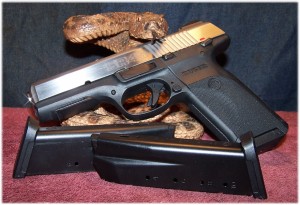 The pistol ships with two steel, 10-round magazines with polymer followers and base-plates. The magazines include convenient witness holes to account for all 10 rounds. The base-plates feature a slightly extended finger rest and gripping grooves to make removal easier and faster, although the magazines do drop free under normal circumstances. A metal mag-loading tool is also included, but I prefer an UpLula loader.
The pistol ships with two steel, 10-round magazines with polymer followers and base-plates. The magazines include convenient witness holes to account for all 10 rounds. The base-plates feature a slightly extended finger rest and gripping grooves to make removal easier and faster, although the magazines do drop free under normal circumstances. A metal mag-loading tool is also included, but I prefer an UpLula loader.
The magazines are metal with polymer followers and work wonderfully. To cram a full load of 10-rounds in the magazine; however, you will not need an assistant as all ten can be loaded just fine. Considering that the magazine hold ten rounds, the overall length of the grip is not longer than a Government model 1911 loaded with an 8-round Wilson Combat magazine with bumper pad.
DISASSEMBLY AND REASSEMBLY:
Disassembling, and subsequent reassembly, is not a difficult process but it does have quirks.
Disassembly:
Without going into detail that the Ruger SR45 manual can tell you, I’ll just cover the quirks:
Quirk #1 – The trigger must be pressed forward to remove the slide from the frame.
Quirk #2 – The ejector must be pushed forward and down to remove the slide from the frame.
The SR45 incorporates a Takedown Pin Assembly. Once the slide is locked back, the Takedown Pin Assembly is simply pushed from the frame. The, while maintaining a good hold on the slide, the slide is pulled slightly rearward and then forward off of the frame.
Reassembly:
Without going into detail that the Ruger SR45 manual can tell you, I’ll just cover the quirks:
Quirk #1 – The trigger must be pressed forward to assemble the slide to the frame.
Quirk #2 – The ejector must be pushed forward and down to assemble the slide to the frame.
Once the above conditions have been met, the slide is installed into the frame until the slide can be locked into place with the Slide Stop Lever Assembly. Insert the Takedown Pin Assembly. Pull the slide slightly rearward to release the slide and then allow the slide to slowly go into battery.
Then, insert an empty magazine to push the Ejector back into place. Perform a function check and you are finished.
HOW IT CARRIES:
The SR45 is certainly no pocket pistol, and the brushed and matte stainless steel slide seems very large when viewing the pistol from the rear or front. The grip of the SR45 looks very large also from the side, but the grip is no harder to conceal than is a “Government” model or “Commander” model 1911.At this time I only have one holster for the SR45, an IWB Super Tuck Deluxe holster from Crossbreed Holsters. It was intended to house the SR9 and SR9c pistols. Because of the identical width of the SR45 to these pistols, the holster works well. The SR45; however, is slightly longer than the SR9 (and the SR40) so a tad bit of the muzzle protrudes beyond the leather backing of the holster. The holster is; however, adequate for IWB carry should I decide to do so. I prefer the slide and muzzle be fully protected and a holster like Alien Gear or SHTF Gear may be more to my liking.
Because of the length of the grip, I add a step more forward cant to the holster to help pull the grip more forward. I do the same regardless of the pistol carried so concealing the SR45 is not different from concealing other pistol long or short. Like the 1911, the grip of the SR45 is pulled tightly into my side and this helps to reduce the footprint of the grip.
To carry the SR45 OWB, there are many fine holsters available with open and closed ends. I prefer the latter. One such holster that I have is from Simply Rugged and intended to house the Springfield XD Service model. The SR45 fits perfectly in this holster and I have the option to use the holster on the belt as an OWB holster or IWB with the optional leather straps. The cant of the holster; however, is not adjustable as I would like.
I contacted SHTF Gear about a holster. The SR45 is not listed among the rest of the SR series pistols. While the SR45 might work in a holster intended for the other SR series of pistols, the barrel and slide is slightly longer. SHTF Gear responded back that they have ordered a blank to make the holster and I should be able to order one as soon as they list it on their website in a week or two. I like SHTF Gear; some great people making things happen!
RANGE TIME:
The SR45 is one of the most pleasant of pistols I have had the privilege to shoot. Even though the pistol is light, its full size makes recoil very manageable. Because of the exceptional trigger, controlling this beast comes down the operator’s skill in hitting what he or she is aiming at.
I have about 250-rounds through this pistol, which includes some good defensive loads, and the pistol has performed without failure.
At ten yards distance, it is quite easy to assign bullets to the X-ring if you do your part. The SR45 has a low bore-axis and recoil is as back into the hand as possible. If you use proper shooting techniques, the pistol is very easy to return back to the target after recoil.
Again, I have to give kudos to the grip area. Getting a good, firm grip on a pistol is tantamount to good pistol handling and the Ruger SR45 pleases me with its grip shape and size in many ways. Some would say that the grip of the SR45 is tool long. It is not really, it just appears that way. In all honestly, I find the grip of the SR45 much more compatible with my hand than the Glock G17 and even some 1911-based pistols.
SOME REPORTED NEGATIVES:
There have been three reported negatives on the pistol that I am aware of:
Issue #1 – Failure to chamber a round:
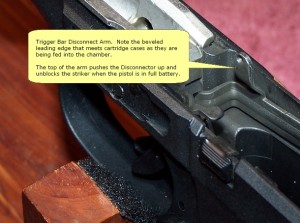 This issue seems to stem around the clearance between the tab of the trigger bar that contacts the trigger disconnector and the actual round being chambered. This seems to be a design issue, because the leading edge of the tab is beveled slightly so that if contact between the Trigger Bar Disconnector Arm (for lack of a better definition) does contact the mouth of a cartridge, the cartridge should simply pass by the Disconnector Arm freely and chamber the round. If the clearance is too tight, and possibly if the cartridge is too large, the possibility of round jamming could exist.
This issue seems to stem around the clearance between the tab of the trigger bar that contacts the trigger disconnector and the actual round being chambered. This seems to be a design issue, because the leading edge of the tab is beveled slightly so that if contact between the Trigger Bar Disconnector Arm (for lack of a better definition) does contact the mouth of a cartridge, the cartridge should simply pass by the Disconnector Arm freely and chamber the round. If the clearance is too tight, and possibly if the cartridge is too large, the possibility of round jamming could exist.
What to Check:
If you are in the market for a Ruger SR45, and have an opportunity to handle one at a local gun shop, carry a Snap Cap (a dummy round) with you. Ask the salesperson if you can use the Snap Cap to check the clearance between the Trigger Bar Disconnector Arm and the dummy round. He will either consider you an informed consumer or a complete idiot. However, with the knowledge you have just gained, and will gain, you can show them the issue. They really don’t want to know; however, because they simply want you to buy the gun.
If allowed to continue, pull the slide to the rear and lock it into place, insert the round into the magazine, insert the magazine into the pistol, hold the slide firmly while pulling rearward until it unlocks. Then, look into the chamber and slowly allow the slide to go forward (not completely) as you observe the clearance between the case of the dummy cartridge and the Trigger Bar Disconnector Arm. At worst case, and if the clearance is too tight, this might force the cartridge against the side of the chamber mouth and prevent the cartridge from chambering. However, and in most cases, the Trigger Bar Disconnector Arms simply slides smoothly alongside the cartridge case.
Ruger is aware of the issue and this may have occurred in early models.
The Trigger Bar Disconnector Arm has some lateral play and simply moves to the side when it engages with the cartridge. Failure to feed should be a non-issue as it is with my particular SR45. It may be worth checking if you are going to purchase a used SR45, because the reason it is a used pistol could have been because of failure to feed and the previous owner didn’t care to fix it.
Wouldn’t it be nice if, as with vehicles, there was an online source that listed issues with various firearms in a central location?
Issue #2 – Light primer strikes:
There have been reports of light primer strikes by several owners of the SR45 using a wide and varied choice of ammunition. To date, I have not experienced any. Again, this issue was with early SR45s and may no longer be an issue. Unfortunately, this is something that you cannot check until you shoot the pistol.
Issue #3 – Magazine not releasing properly (intermittent)
The magazine release (Part 39) on the SR45 is ambidextrous; it releases the magazine from the front of the magazine when the Magazine Release button is pressed form either side. The issue was reported that when the slide was closed, a magazine might not fall free as it is supposed to. When the slide was back and locked, the magazine would fall free every time.
To date, I have not had any magazine issues. When the magazine locks into place, there is some play at the bottom of the magazine. This is normal. Also, you need to be somewhat aggressive when inserting a full magazine to ensure that it locks into place.
When you insert the magazine into the magazine well, you will eventually feel resistance. This resistance is when the magazine latch makes contact with the magazine.
What to Check:
Ensure that the magazine is fully inserted into the magazine well and clicks into place and ensure that the magazine falls free regardless of the position of the slide.
THE FINAL WORDS:
 The SR45 is a complex pistol that needs 64 parts (including magazines) to complete the whole, which is 18 more parts than a standard 1911-based pistol. However, and like the 1911-based pistol, the SR45 uses all the parts in an exceptional manner.
The SR45 is a complex pistol that needs 64 parts (including magazines) to complete the whole, which is 18 more parts than a standard 1911-based pistol. However, and like the 1911-based pistol, the SR45 uses all the parts in an exceptional manner.
The SR45 is a full-size bedroom or belt battle gun for the civilian. Currently, the SR45 MSRP is $569, and of course can be found for less on the open market. The open market cost places the SR45 within the budget constraints of most; you get a lot of pistol for your money.
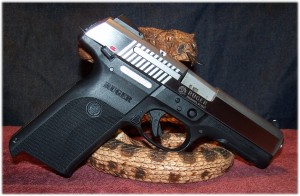 With my experience with the Ruger SR9, SR9c, and SR45 I feel almost bad about not having one in .40 Smith & Wesson. If a .40 Smith and Wesson pistol is in my future, the SR40 would be seriously considered among the top runners. However, if Ruger decides to manufacturer a SR45c, as they have with the SR9 and SR40, there would be one in the stable. Ruger, are you listening?
With my experience with the Ruger SR9, SR9c, and SR45 I feel almost bad about not having one in .40 Smith & Wesson. If a .40 Smith and Wesson pistol is in my future, the SR40 would be seriously considered among the top runners. However, if Ruger decides to manufacturer a SR45c, as they have with the SR9 and SR40, there would be one in the stable. Ruger, are you listening?
My particular SR45 has the stainless steel slide, which I prefer in the hot Southern climate. I do like the black Nitride-treated carbon steel slide for concealment, only due to my selection of clothing (usually a black t-shirt). Overall; however, the stainless steel version is my choice.
While I don’t currently carry the Ruger SR45 as an EDC, I can highly recommend it for HD, SD, just having a good experience at the range, or even for competition in the stock pistol class.
RESOURCES:
- Ruger SR45: http://ruger.com/products/sr45/models.html
- Gun of the Week: Ruger SR45: https://www.youtube.com/watch?v=2cKTay3erqM
- SHTF Gear: http://www.shtfgear.com/
- Alien Gear Holsters: http://aliengearholsters.com/
- Simply Rugged Holsters: http://www.simplyrugged.com/
- Crossbreed Holsters: http://www.crossbreedholsters.com/
![]()



